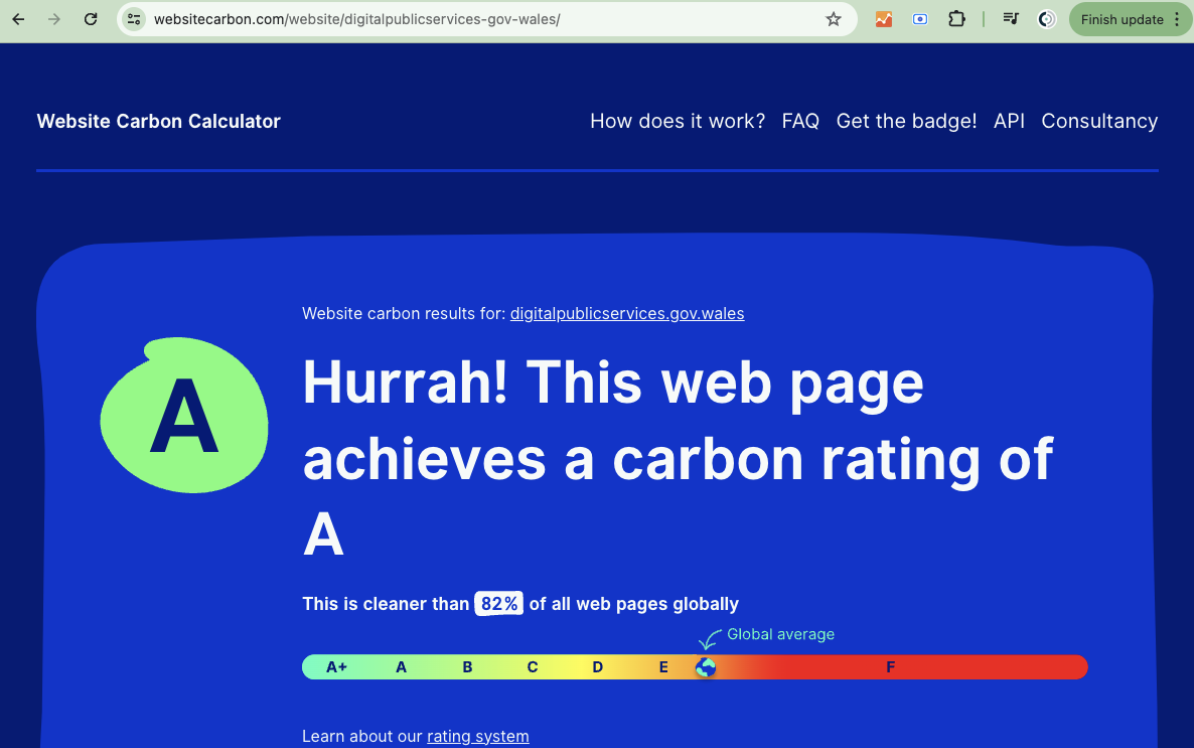World Earth Day takes place on 22 April every year and aims to raise awareness of environmental sustainability across the globe. We have been looking to raise awareness of the role digital plays in sustainability as there is one year left until the end of Welsh Government’s second carbon budget.
As communications professionals, what can we be doing to contribute to net zero targets?
Our Communicating Digital community of practice recently welcomed digital sustainability expert, Marketa Benisek from Wholegrain Digital, to share her insights on the topic.
Here’s my reflections on what she shared:
Digital pollution – an invisible problem?
When I think of pollution, I instantly think of rubbish dumps, plastic in the ocean and smoke in the sky. Marketa highlighted that we don’t see digital as being polluting due to the language used to describe it. Terms such as the cloud, virtual and wireless makes it feel very non-physical. But everything we do virtually has an impact:
Data = electricity = CO2
And the more data we need to transfer, the more energy that is required which leads to more emissions. Every single social media post, Google search, email, and ChatGPT question are generating tiny amounts of CO2, and all of this builds up.
The internet alone contributes between 2.1% - 3.9% of annual global carbon emissions with the UK annual emissions at 1.1% and global aviation industry annual emissions contributing 2.1%. So, the internet is a big contributor when you compare it.
Just a drop in the ocean?
Marketa shared some great stats with us to put it into context. Did you know that every Google search contributes 0.2g of CO2 which is the same weight as a drop of water? With 8.5 billion Google searches happening every day that’s 17,000 tonnes from Google searches alone which is the same weight as 11 blue whales.
Bookmarking pages and reducing your Google searches is a simple way you can help.
Think before you thank
Marketa also shared insights into the impact of email marketing on CO2 emissions. A study by OVO energy found that if every adult internet user in the UK sent one less unnecessary email (an email of 4 words or less) a day we would save 16,433 tonnes of carbon a year – the same as 81,152 flights to Madrid or taking 3,334 diesel cars off the road.
Examples of unnecessary emails include:
- Thank you
- Thanks
- Have a good weekend
- Received
- Appreciated
- Have a good evening
- Did you see this?
- Cheers
- You too
- LOL
Sustainable inbox
We came away with some practical tips we could all be doing to reduce the CO2 produced by our inboxes, these included:
- declutter your inbox and unsubscribe from unwanted emails
- avoid ‘Reply all’
- use links instead of attachments
- regularly archive or delete old emails
- shorten email signatures
- stay mindful of BCC and CC usage
- think before sending
- quality over quantity
As a communications professional, I am a little bit obsessed by numbers and data. How do I know if a campaign is successful if I haven’t been measuring it? When it comes to email marketing, Marketa made a good point with prioritising quality over quantity. You could have 20,000 people on your mailing list but if only 0.2% are opening and reading it you are just adding to the digital clutter. It’s important that your email is received by those who care so review your mailing lists regularly. If there are people on your lists that haven’t opened in a while – send them a separate email asking if they still want to hear from you.
Measuring your impact
As well as keeping an eye on open rates, there are other areas you can monitor. Tools to measure carbon impact on websites have been around for a while but have you used them to monitor how green your website is? Wholegrain Digital have developed a tool called websitecarbon.com. The tool looks at things like how much CO2 is produced every time someone visits a webpage as well as the green credentials of the data centre that hosts the site.
I was interested to see how the CDPS website would fair and was pleased to see we achieved an A rating:

There are simple ways you can reduce the CO2 on your website, including:
Video
- Only including videos that are essential or the best way of conveying a message.
- Disabling autoplay – autoplaying generates waste in the background – as it reloads continuously if you have the tab open. Disabling autoplay will minimise this.
- Removing audio on video (where necessary). This reduces files size which reduces waste.
- Green video hosting. Make sure the video hosting provider is using green energy themselves. YouTube and Wistia use green energy
Images
- The type of image you feature. A study by Nielsen Norman Group found that some types of images are completely ignored.
- Removing images completely. Could you use typography more creatively?
- Image format. Rather than using a .jpeg you could convert to WebP or AVIF images which are highly optimised for the web and lighter in file size.
Get accredited
CDPS recently achieved the Carbon-Conscious Website Accreditation from the Eco-Friendly Web Alliance. This accreditation is awarded to organisations that have websites that produce less than 1gram of CO2 per webpage. It’s a way of showing our commitment to reducing carbon emissions.
You can undergo a free audit to see how your site is performing before applying for accreditation.
What will you do first?
Marketa shared so many different tips and examples. If you attended, what’s on the top of your to-do list?
If you want to join a supportive community of communications professionals, find out more about our Communicating Digital community of practice.
A huge thank you to Marketa for such an inspirational talk, take a look at Wholegrain Digital’s examples of how they have supported organisations to become greener.
